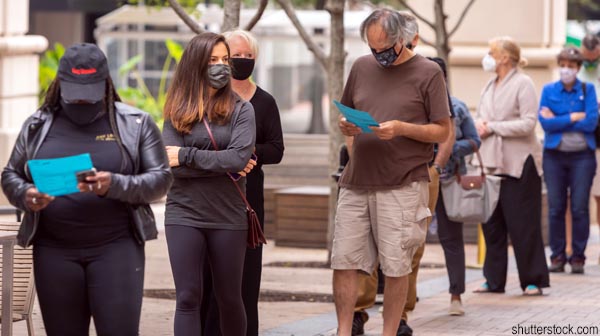
In addition, voters should expect to arrive at polling locations early and expect to wait. They can minimize their time and risk of COVID-19 by filling out a sample ballot prior to election day to make in-person voting time-efficient, vote during an off-peak time, and come alone to the polling location.
Explore This Issue
ACEP Now: Vol 39 – No 10 – October 2020Election day does not happen without poll workers, and wide-scale campaigns to recruit extra workers may reduce the burden of individual exposures to others. Poll workers should be trained in the appropriate use of personal protective equipment and offered free testing for COVID-19 before and after their shifts at the polls. Any individual concerned about their personal risk for COVID-19 as a poll worker should consult their physician.
COVID-19 is the greatest social, health, and economic threat of our generation. As we approach Nov. 3, it is critical that local communities, health care workers, and public health departments work together to minimize the risk of COVID-19. We have the knowledge and scientific evidence to have a safe election. Now is the time to implement policies and practices and keep our patients informed about them. No person should have to choose between the right to vote and the right to be healthy.
Disclosure: Dr. Kuppalli is a consultant for GalaxoSmithKline.
References
- Considerations for election polling locations and voters: interim guidance to prevent spread of coronavirus disease 2019 (COVID-19). Centers for Disease Control and Prevention website. Available at: https://www.cdc.gov/coronavirus/2019-ncov/community/election-polling-locations.html. Accessed Sept. 28, 2020.
- Sun K, Viboud C. Impact of contact tracing on SARS-CoV-2 transmission. Lancet. 2020;20(8):876-877.
- Beidas RS, Buttenheim AM, Feuerstein-Simon R, et al. Optimizing and implementing contact tracing through behavioral economics: contact tracing is not just about making phone calls. NEJM Catalyst website. Available at: https://catalyst.nejm.org/doi/full/10.1056/CAT.20.0317. Accessed Sept. 28, 2020.
- Lazer D, Baum MA, Ognyanova K, et al. The state of the nation: a 50-state COVID-19 survey. Katya Ognyanova website. Available at: http://www.kateto.net/COVID19%20CONSORTIUM%20REPORT%20April%202020.pdf. Accessed Sept. 28, 2020.
- H.R. 2–National Voter Registration Act. Congress website. Available at: https://www.congress.gov/bill/103rd-congress/house-bill/2/text. Accessed Sept. 28, 2020.
- Health Center Tool Kit. Community Health Vote website. Available at: http://communityhealthvote.net/toolkit/. Accessed Sept. 28, 2020.
- VotER website. Available at: https://vot-er.org. Accessed Sept. 28, 2020.
- Stockman F. In era of sickness, doctors prescribe unusual cure: voting. The New York Times website. Available at: https://www.nytimes.com/2020/07/25/us/in-era-of-sickness-doctors-prescribe-unusual-cure-voting.html. Accessed Sept. 28, 2020.
- Brennan Center for Justice, The Infectious Diseases Society of America. Guidelines for healthy in-person voting. Brennan Center for Justice website. Available at: https://www.brennancenter.org/our-work/research-reports/guidelines-healthy-person-voting. Accessed Sept. 28, 2020.
Pages: 1 2 3 4 | Single Page





No Responses to “Safe Elections During COVID-19: The Role of Emergency Medicine”